This article may contain affiliate links. If you make a purchase after clicking on a link we may earn a small commission at no extra cost to you. As an Amazon Associate, I earn from qualifying purchases.
White Crappie vs Black Crappie – What’s the Difference?
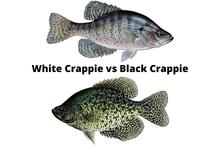
Most anglers think the main differences between white crappie vs black crappie are only superficial, but that’s not quite the case.
Crappie are widely considered to be the most popular species of panfish in North America, which is a notable distinction considering the fact that there are dozens of panfish species and variations present in the United States and Canada.
If you’re one of the many anglers who are not aware of the differences between white crappie vs black crappie, we’ve compiled this article to serve as a handy guide for distinguishing between the two.
Crappie Overview
For many anglers, it’s not quite as easy as it might seem to tell the difference between black and white crappie. In many cases, these two species very closely resemble one another, but they also have certain distinct characteristics and qualities that set them apart.
Crappie from both species groups are among the most sought-after fish in North America due to the fact that their thin, sweet-tasting fillets are excellent table fare.
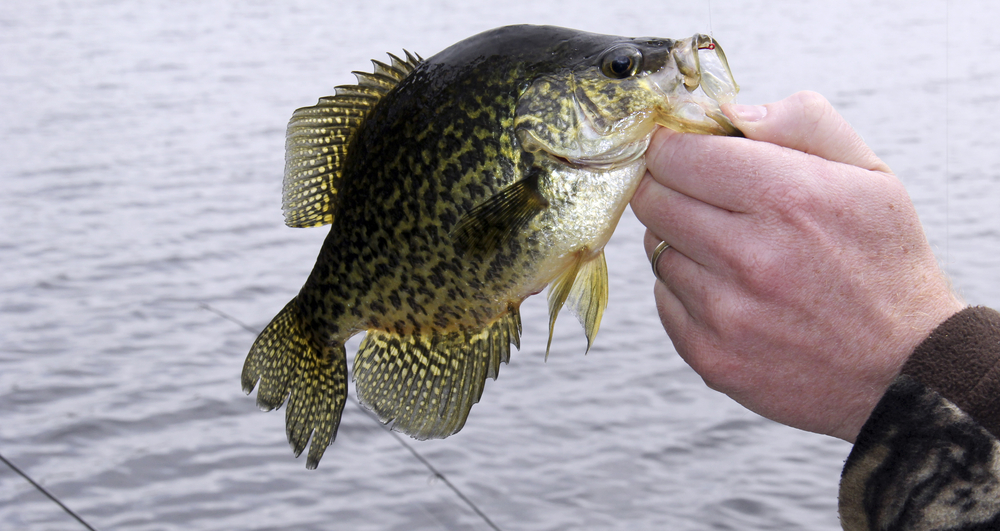
It’s understandable that even some experienced anglers can become confused with the differences between white vs black crappie as there are actually more variations known to exist throughout the continent.
The IGFA recognizes 7 different species of crappie and some of these are only found in certain geographic areas of the United States.
Crappie are part of the Sunfish family, but they are known as panfish among anglers due to the fact that their body shape is perfectly proportioned to fit inside the average frying pan.
White crappie and black crappie are known to be virtually the same size in many cases, but there are some slight and subtle differences in their growth rate and the way their bodies change as they grow older and larger.
All 7 different variations of crappie belong to the same Pomoxis genus within the Sunfish family. In order to fully understand these two species and have the ability to distinguish one from another, we’ll discuss more about white crappie vs black crappie in the following sections, including the finer details about each species.
White Crappie
Much like any other crappie species, white crappie are a very social fish species. They are known to congregate with large schools of their own kind for virtually the entire year.
If you manage to catch a white crappie in a large lake or reservoir, you might want to thoroughly fish the area as it’s nearly guaranteed that there will be more in that same area or very near to it.
As a prominent freshwater fish in North America, the white crappie can be found in many different lakes and rivers stretching throughout most of the United States and Canada. They are native to the Mississippi River system and the state of Mississippi is largely considered to be the crappie capital of the United States.
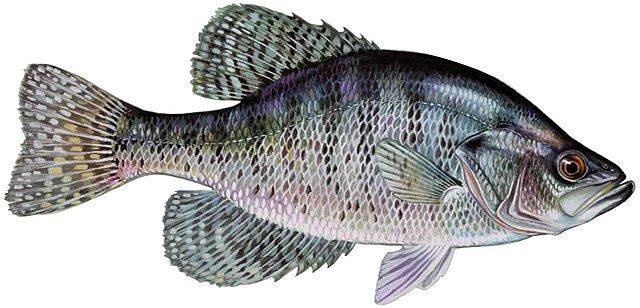
White crappie are quite different from black crappie in their chosen habitat. They often like to remain in deeper sections of the lakes and reservoirs where they are found, but white crappie are not quite as skittish and will congregate in open water instead of hugging tightly to certain types of cover.
The topic of whether white crappie are more inclined to live in rivers than black crappie has been debated for many years and there is ample evidence that shows white crappie generally prefer to live in large, slow-moving rivers or big reservoirs that these rivers feed into.
White crappie are very common throughout the Midwest and states along the Deep South, but it’s rare to find them in some of the northernmost states as the cold winters are not preferred by these fish.
Black Crappie
Black crappie are aptly-named as you can clearly notice their black coloration on most of these fish. However, some black crappie have a much lighter coloration than others, leading some anglers to mistakenly assume that they are white crappie.
Black crappie are known under the scientific name Pomoxis Nigromaculatus and are one of the more unique variations of fish within the 7 different crappie species known to exist in the United States.
While the white crappie likes to live in open water, you can expect to find black crappie very close to some type of submerged, deep-water cover in most cases.
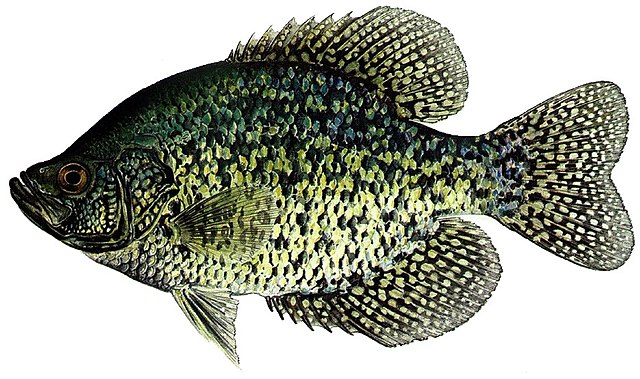
Many biologists believe that these fish have specifically evolved with their darker coloration as a means to hide near underwater logs, brush piles, rocks and other types of cover where they can more easily ambush their prey.
Black crappie have a slightly larger range than white crappie if you were to compare the two species’ natural habitats on a map of North America. They are found in virtually any river, lake or reservoir where white crappie are known to live, but some waterways have only black crappie in them.
Black crappie are native to the eastern and southern portions of the United States, but they have been introduced to lakes and reservoirs all across the country over the last 100 years.
Many of these lakes where they have been introduced are areas where black crappie tend to thrive, especially in states like California and Arizona that offer warmer climates.
Crappie Spawn
Black and white crappie have very similar spawning routines which they engage in at the onset of warmer weather in the spring of each year.
When the water temperature begins to warm up and reaches roughly 55 degrees Fahrenheit, you can expect both black and white crappie to begin their annual migration upward in the water column toward more shallow sections of their home body of water.
In large lakes and reservoirs, white and black crappie will start moving into coves where they can stage on points and locate certain sections where the males will create a nest in 2 to 6 feet of water in the back of a cove before the female comes in to lay her eggs.
Crappie often lay more than 10,000 eggs at a time, but most of the fry that come from these hatches will end up as food for other crappie and many other types of freshwater fish species.
White Crappie vs Black Crappie Differences
It’s true that it can be tough to distinguish white and black crappie from one another, but these identification points can be used to tell them apart with relative confidence for anglers who pay close attention to their catch.
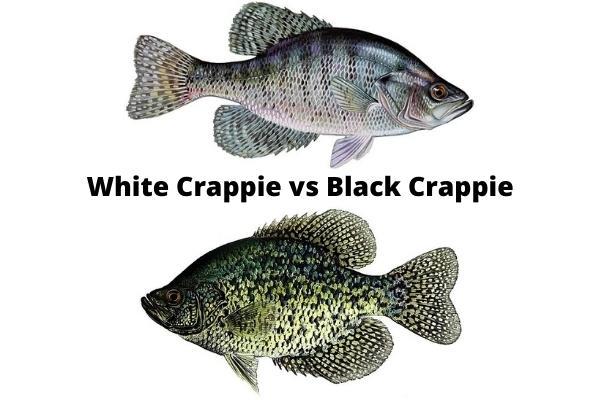
Markings & Color Pattern
For avid crappie anglers, the difference between white vs black crappie is often obvious with a single glance. Yet, others might not realize the subtle differences in the markings and color patterns that white and black crappie possess. These color and marking differences are hard to confuse and once you begin to notice it on your fishing trips, it will become relatively easy to tell white crappie from black crappie.
The white crappie will have a much lighter coloration on their sides, but sometimes black crappie might have a very light pattern themselves. It’s important to pay special attention to the black specs on crappie in order to tell whether the fish is a white or black crappie.
White crappie will have distinct specks that connect to form more obvious, dark-colored vertical stripes along their sides. Many times, these stripes can appear as if they wear with age, but some variations of white crappie have very clear and obvious black stripes along their sides.
Black crappie will have these same black specs all over their body in no significant pattern. They will always have more of these black specs along the upper portion of their body, especially along their backs, but these black specs often resemble a black-and-white digital camo pattern. In some cases, black crappie will have a much darker and obviously black coloration.
Dorsal Fin Spines
If you’re examining the fish and you’re still not quite sure whether it’s a black or white crappie, you can rely on another method to identify it. The dorsal fins of white crappie are known to have only 5 or 6 spikes while black crappie will have a few extra. You can always expect black crappie to have at least 7 ot 8 spikes on its dorsal fin and some anglers rely on counting these spikes to be fully certain of their catch.
Body Length
Lastly, the other difference between white and black crappie is one that’s more subtle and harder to identify for some anglers. White crappie often have a longer body than black crappie, despite the fact that their body profiles remain more rounded in both species. A trophy size black crappie might measure 13 inches while a trophy-sized white crappie can exceed 16 inches in some instances.
Conclusion
It’s fully understandable for some anglers to be confused about the differences between white vs black crappie, but you can gain a more solid understanding of each species using the information and identification factors provided in this article.
